
© Copyright Goldendoodles.com 2001. All rights reserved. You may not copy or otherwise use anything on this site without our written permission.
FAQ: AUSTRALIAN LABRADOODLES
History
The Labradoodle story begins with Wally Conron, the head breeder of the Australian Guide Dog Association, who coined the name in 1989 when he bred a litter of Labrador Retriever - Standard Poodle cross pups. Pat Blum had lived with vision impairment for many years, but never could apply for a Guide Dog because of her husband's problem with allergies. Pat approached Wally and was overjoyed when the AGDA agreed to breed a litter of Labradoodle pups, hoping the Poodle cross would lessen the likelihood of an allergic reaction. Harley the Standard Poodle was bred to Brandy the Labrador Retriever and three pups, Sultan, Sheik and Simon were conceived. As Pat and her husband lived in Hawaii, fur samples of the 3 pups were sent to Pat at different ages. Sultan's coat was the only one that caused no problem at all. Sultan trained well as a Guide Dog and was united with Pat for the first time at eighteen months old. Labradoodles became very popular among the blind in Hawaii, and Wally has said that 29 of the first 31 Labradoodles he bred were successfully trained as Guide Dogs, although only one in ten were reliably allergy friendly. The Australian Guide Dog Association continues to breed one or two litters of Labradoodles a year due to their popularity. Dr. Kate Schoeffel, a friend of Wally Conron, is an honours geneticist and Vet in Condoblin, New South Wales, Australia. Kate was the first to breed pet Labradoodles, and still breeds miniature Labradoodles to this day. In the early 1990's two associated kennels in Australia, with a background in Spoodles (Australian for Cockapoos, a Cocker Spaniel - Poodle mix) began to breed Labradoodles to Labradoodles and Labradoodles to Poodles, breeding toward a consistently allergy friendly and nonshed dog. Other breeds were introduced into the mix as well. (The IALA is in the process of confirming the use of these purebreds) • Curly Coated Retriever - this didn't work out and these lines were abandoned • Irish Water Spaniel - two dogs were used in the program, one time each The other breeds successfully introduced to the program were Cocker Spaniels. • English Cocker Spaniel • American Cocker Spaniel In 1999 these new lines of dogs were introduced to North America where they took off like gangbusters! Those breeders who carefully selected breeding dogs and promoted health testing joined together to form the first association created to protect the qualities of the multigeneration Labradoodle, the Labradoodle Association of Australia (LAA). The LAA was founded in June of 2000, and began a computer database to record and track the pedigrees of the multigeneration Labradoodle. As the founding parent body of the Australian Labradoodle, it is their goal to submit the Australian Labradoodle breed standard to the Australia National Kennel Club (ANKC) for breed recognition when the required criteria are met. The International Labradoodle Association (ILA) was incorporated in 2004 and began to work with the LAA towards the protection of the Labradoodle's future. Their goal is to focus on nurturing the development of the Labradoodle and promoting uniform breeding standards to insure the health and integrity of the breed.The Australian Labradoodle Today
In 2005 The International Australian Labradoodle Association, IALA, was founded as a global organization, uniting the existing sister organizations. These sister associations include : • the Australian Labradoodle Association, ALA (formerly the LAA) • and the Australian Labradoodle Association of America, ALAA (formerly the ILA ) Working together, the breeders have developed stringent guidelines in health testing and a more comprehensive breeding program. One of the most important qualities for a healthy, viable new breed is to build a large and healthy number of foundation stock with a broad genetic diversity. The IALA oversees new lines being added from around the globe, each bringing renewed health and vigour into old lines. They have compiled the largest Labradoodle database in the world. As of September 2006, there are almost 3000 registered dogs and over 3000 additional ancestors in the database. Health Testing As science moves forward, the IALA breeders embrace new technologies that offer them more insight into their breeding programs. Although each sister organization has its own specific code of ethics and conduct, all IALA members are recommended or required to administer certain tests to their breeding dogs.The Planned Future
Steps Towards Breed Recognition: Breed recognition is many years away, both in Australia and in the U.S. New breeds develop through a series of processes - • Foundation dogs - For the next decade or so, new bloodlines will be added to the Australian Labradoodle to create a healthy and diverse genetic background. Guided by their breeding committee, they will breed towards the breed standard they have set. • Breeding to purebred -- When the `books are closed' on the Foundation lines, only the intact dogs within this pool will go on to breed towards a purebred Australian Labradoodle. ANKC Breed Recognition Breeders in Australia have contacted the ANKC and discussed more specifics on the requirements for breed recognition, and have updated and improved the breeding program accordingly. ANKC requirements for breed recognition: “In regard to the Regulation that requires a minimum time the breed has been in existence be fifteen [15] years, means that there has had to be an organisation (usually an Incorporated Club) covering the whole of Australia that has acted as the Stud Book Register for the breed for a minimum of fifteen [15] years. This organisation must have kept records of all dogs bred in the breed. The minimum number of dogs registered be 500. This means that at the time of application there must be 500 of the breed alive and registered with the above organisation. All of the 500 dogs must be entire (none of them to be neutered). The minimum number of generations registered be 5. This means that only those dogs with a 5-generation Pedigree will be eligible for acceptance on to the ANKC register at the time if and when is adopted as an official ANKC Breed. The 5 generation Pedigree does not apply to the 500 dogs on the Register.” AKC Breed Recognition The ALAA has contacted the AKC, although the Australian Labradoodle does not currently meet its definition of a possible purebred, the ALAA is taking all the necessary steps to allow the AKC to accept the ALAA's database into it's foundation services program at a future date. AKC requirements for breed recognition: After the books have closed, the Foundation dogs must then be bred to each other for a minimum of 3 generations. There must be at least 300 dogs in the U.S. in at least 20 states with this background (of only Foundation dogs breed to each other for 3 generations) for the breed to even petition for recognition. The National Club will then petition the AKC for recognition to the Misc. class. Once accepted the AKC offers Open registration to only those dogs (that are 3 generations from the Foundation dogs) and are whelped in the US. This is independent of original pedigree and number of breeds in the mix. The pedigree for the early Foundation dogs will be kept by the National Club database. The AKC will track the pedigree in their system but will not list AKC numbers for Foundation dogs but the National Club numbers. Steps Towards Breed Health and Longevity The IALA encourages all Member Breeders to health test their breeding stock. Recommended basic tests include hip and elbow exams, yearly physicals with CBC and biochemical profiles, and annual EYE/PRA exams. Breeders who have submitted DNA parentage identification profiles on all breeding dogs an IALA/ALAA member may place the following statement on their website. "Our breeding dogs are IALA/ALAA DNA profiled. All of our breeding dogs have been DNA'd and their DNA profiles have been submitted to the IALA/ALAA. This has been done to protect the buyer and support parentage identification. The IALA/ALAA strongly recommends this profiling of its members and we are proud to be an IALA/ALAA/DNA breeder." Steps Towards Ethics in Breeding All IALA/ALAA members have pledged to a stringent Code of Ethics which includes Rules & Regulations that are updated quarterly. The ethics code is extensive and includes; • standards in housing and caring for dogs and pups • candor about all aspects of the breeding program • ethical treatment of dogs and choices in breeding practices • identification and record keeping requirements • a pledge to represent the dogs honestly and provide materials to better educate owners Some of the statements in the Code are broad and open to interpretation, and so with each new quarter year, new procedures and standards of excellence are sent to all the breeders, refining and defining specific parts on the Code. Bi-monthly letters are also sent out with updates in health testing, or any issues that may affect the health of these foundation lines of Australian Labradoodles. (Many thanks to Krista Waitz of Rainmaker Ranch Australian Labradoodles and the IALA, and to Kathy Young from Cloudcatcher Labradoodles and the AALA, for all their efforts in helping to put together this informational page.) (top photo courtesy of Olympic Labradoodles)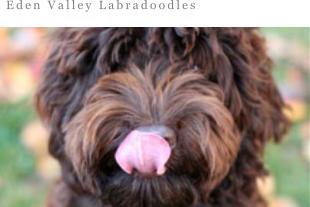

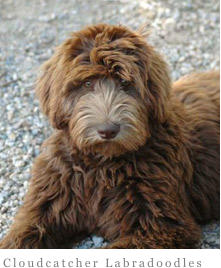
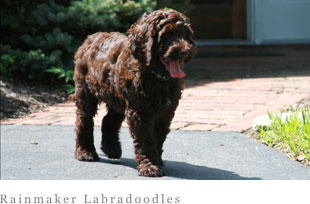


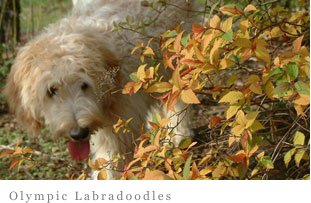



Goldendoodles.com

© Copyright Goldendoodles.com 2001. All rights reserved. You may not
copy or otherwise use anything on this site without our written permission
FAQ:
AUSTRALIAN
LABRADOODLES
History
The Labradoodle story begins with Wally Conron, the head breeder of the Australian Guide Dog Association, who coined the name in 1989 when he bred a litter of Labrador Retriever - Standard Poodle cross pups. Pat Blum had lived with vision impairment for many years, but never could apply for a Guide Dog because of her husband's problem with allergies. Pat approached Wally and was overjoyed when the AGDA agreed to breed a litter of Labradoodle pups, hoping the Poodle cross would lessen the likelihood of an allergic reaction. Harley the Standard Poodle was bred to Brandy the Labrador Retriever and three pups, Sultan, Sheik and Simon were conceived. As Pat and her husband lived in Hawaii, fur samples of the 3 pups were sent to Pat at different ages. Sultan's coat was the only one that caused no problem at all. Sultan trained well as a Guide Dog and was united with Pat for the first time at eighteen months old. Labradoodles became very popular among the blind in Hawaii, and Wally has said that 29 of the first 31 Labradoodles he bred were successfully trained as Guide Dogs, although only one in ten were reliably allergy friendly. The Australian Guide Dog Association continues to breed one or two litters of Labradoodles a year due to their popularity. Dr. Kate Schoeffel, a friend of Wally Conron, is an honours geneticist and Vet in Condoblin, New South Wales, Australia. Kate was the first to breed pet Labradoodles, and still breeds miniature Labradoodles to this day. In the early 1990's two associated kennels in Australia, with a background in Spoodles (Australian for Cockapoos, a Cocker Spaniel - Poodle mix) began to breed Labradoodles to Labradoodles and Labradoodles to Poodles, breeding toward a consistently allergy friendly and nonshed dog. Other breeds were introduced into the mix as well. (The IALA is in the process of confirming the use of these purebreds) • Curly Coated Retriever - this didn't work out and these lines were abandoned • Irish Water Spaniel - two dogs were used in the program, one time each The other breeds successfully introduced to the program were Cocker Spaniels. • English Cocker Spaniel • American Cocker Spaniel In 1999 these new lines of dogs were introduced to North America where they took off like gangbusters! Those breeders who carefully selected breeding dogs and promoted health testing joined together to form the first association created to protect the qualities of the multigeneration Labradoodle, the Labradoodle Association of Australia (LAA). The LAA was founded in June of 2000, and began a computer database to record and track the pedigrees of the multigeneration Labradoodle. As the founding parent body of the Australian Labradoodle, it is their goal to submit the Australian Labradoodle breed standard to the Australia National Kennel Club (ANKC) for breed recognition when the required criteria are met. The International Labradoodle Association (ILA) was incorporated in 2004 and began to work with the LAA towards the protection of the Labradoodle's future. Their goal is to focus on nurturing the development of the Labradoodle and promoting uniform breeding standards to insure the health and integrity of the breed.The Australian
Labradoodle Today
In 2005 The International Australian Labradoodle Association, IALA, was founded as a global organization, uniting the existing sister organizations. These sister associations include : • the Australian Labradoodle Association, ALA (formerly the LAA) • and the Australian Labradoodle Association of America, ALAA (formerly the ILA ) Working together, the breeders have developed stringent guidelines in health testing and a more comprehensive breeding program. One of the most important qualities for a healthy, viable new breed is to build a large and healthy number of foundation stock with a broad genetic diversity. The IALA oversees new lines being added from around the globe, each bringing renewed health and vigour into old lines. They have compiled the largest Labradoodle database in the world. As of September 2006, there are almost 3000 registered dogs and over 3000 additional ancestors in the database. Health Testing As science moves forward, the IALA breeders embrace new technologies that offer them more insight into their breeding programs. Although each sister organization has its own specific code of ethics and conduct, all IALA members are recommended or required to administer certain tests to their breeding dogs.The Planned Future
Steps Towards Breed Recognition: Breed recognition is many years away, both in Australia and in the U.S. New breeds develop through a series of processes - • Foundation dogs - For the next decade or so, new bloodlines will be added to the Australian Labradoodle to create a healthy and diverse genetic background. Guided by their breeding committee, they will breed towards the breed standard they have set. • Breeding to purebred -- When the `books are closed' on the Foundation lines, only the intact dogs within this pool will go on to breed towards a purebred Australian Labradoodle. ANKC Breed Recognition Breeders in Australia have contacted the ANKC and discussed more specifics on the requirements for breed recognition, and have updated and improved the breeding program accordingly. ANKC requirements for breed recognition: “In regard to the Regulation that requires a minimum time the breed has been in existence be fifteen [15] years, means that there has had to be an organisation (usually an Incorporated Club) covering the whole of Australia that has acted as the Stud Book Register for the breed for a minimum of fifteen [15] years. This organisation must have kept records of all dogs bred in the breed. The minimum number of dogs registered be 500. This means that at the time of application there must be 500 of the breed alive and registered with the above organisation. All of the 500 dogs must be entire (none of them to be neutered). The minimum number of generations registered be 5. This means that only those dogs with a 5-generation Pedigree will be eligible for acceptance on to the ANKC register at the time if and when is adopted as an official ANKC Breed. The 5 generation Pedigree does not apply to the 500 dogs on the Register.” AKC Breed Recognition The ALAA has contacted the AKC, although the Australian Labradoodle does not currently meet its definition of a possible purebred, the ALAA is taking all the necessary steps to allow the AKC to accept the ALAA's database into it's foundation services program at a future date. AKC requirements for breed recognition: After the books have closed, the Foundation dogs must then be bred to each other for a minimum of 3 generations. There must be at least 300 dogs in the U.S. in at least 20 states with this background (of only Foundation dogs breed to each other for 3 generations) for the breed to even petition for recognition. The National Club will then petition the AKC for recognition to the Misc. class. Once accepted the AKC offers Open registration to only those dogs (that are 3 generations from the Foundation dogs) and are whelped in the US. This is independent of original pedigree and number of breeds in the mix. The pedigree for the early Foundation dogs will be kept by the National Club database. The AKC will track the pedigree in their system but will not list AKC numbers for Foundation dogs but the National Club numbers. Steps Towards Breed Health and Longevity The IALA encourages all Member Breeders to health test their breeding stock. Recommended basic tests include hip and elbow exams, yearly physicals with CBC and biochemical profiles, and annual EYE/PRA exams. Breeders who have submitted DNA parentage identification profiles on all breeding dogs an IALA/ALAA member may place the following statement on their website. "Our breeding dogs are IALA/ALAA DNA profiled. All of our breeding dogs have been DNA'd and their DNA profiles have been submitted to the IALA/ALAA. This has been done to protect the buyer and support parentage identification. The IALA/ALAA strongly recommends this profiling of its members and we are proud to be an IALA/ALAA/DNA breeder." Steps Towards Ethics in Breeding All IALA/ALAA members have pledged to a stringent Code of Ethics which includes Rules & Regulations that are updated quarterly. The ethics code is extensive and includes; • standards in housing and caring for dogs and pups • candor about all aspects of the breeding program • ethical treatment of dogs and choices in breeding practices • identification and record keeping requirements • a pledge to represent the dogs honestly and provide materials to better educate owners Some of the statements in the Code are broad and open to interpretation, and so with each new quarter year, new procedures and standards of excellence are sent to all the breeders, refining and defining specific parts on the Code. Bi-monthly letters are also sent out with updates in health testing, or any issues that may affect the health of these foundation lines of Australian Labradoodles. (Many thanks to Krista Waitz of Rainmaker Ranch Australian Labradoodles and the IALA, and to Kathy Young from Cloudcatcher Labradoodles and the AALA, for all their efforts in helping to put together this informational page.) (top photo courtesy of Olympic Labradoodles)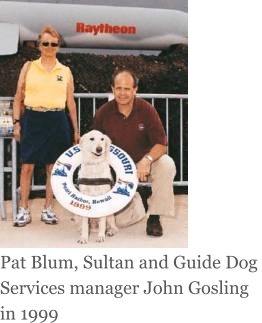

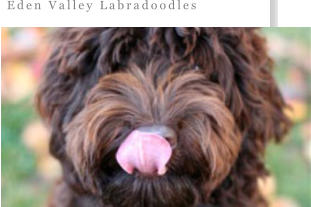
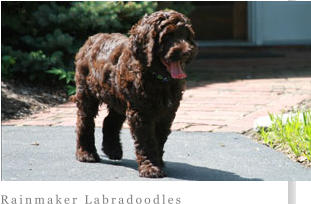
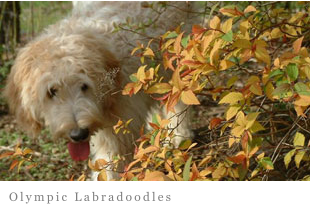
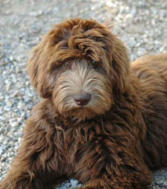
Pat Blum, Sultan and Guide Dog
Services manager John Gosling
in 1999
Cloudcatcher Labradoodles
Eden Valley Labradoodles
Rainmaker Labradoodles

Olympic Labradoodles




